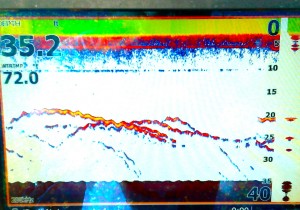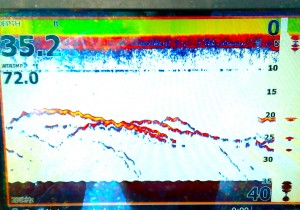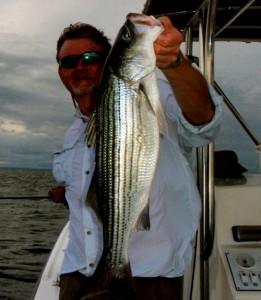dissolved oxygen
 Been fishing lately? If you have, I bet you’ve noticed that there are a lot of suspended fish this time of year. There’s nothing more frustrating to Chesapeake Bay light tackle fishermen than to see nice marks on the fish finder, then not get bites. How do you catch those finicky suspended rockfish? Frankly, it’s tough, but there are some things you can do to increase your chances. To start, consider what’s going on below the surface.
Been fishing lately? If you have, I bet you’ve noticed that there are a lot of suspended fish this time of year. There’s nothing more frustrating to Chesapeake Bay light tackle fishermen than to see nice marks on the fish finder, then not get bites. How do you catch those finicky suspended rockfish? Frankly, it’s tough, but there are some things you can do to increase your chances. To start, consider what’s going on below the surface.
1. Scope Out The Situation – Stripers adjust their feeding habits depending on conditions. Since the Chesapeake Bay is an estuary, conditions can change frequently. Sometimes changes are short-term like those brought on by tides and currents. Sometimes, they last longer like with seasonal water-temperature adjustments. There are even cases where conditions can change for years at a time.
In the near-decade that I’ve been fishing the Chesapeake, I’ve noticed a change, particularly in the warmer months, to more fish feeding in temperate mid-level zones in open water. This can happen when the water conditions on the surface are not as comfortable as they are farther down. In the spring when we get a lot of rain, storm water runs off polluted roads, parking lots, fertilized lawns, and farmer’s fields resulting in a surface layer of unsalted, polluted water. Stripers will come up to feed in this layer when conditions are good and when they’re very hungry, but they’ll drop back down into the comfort zone when they aren’t extremely active. They usually won’t swim down deeper than forty feet or so because the water down deep may not hold enough oxygen, or the temperature or salinity can be uncomfortable for them. Read More!
 Suspended fish, I hate ‘em. Scattered fish suspending in deep water is one of the most difficult situations a light tackle angler will encounter on the Chesapeake Bay. In years past, I’ve refused to target suspended fish. I’d rather run fifteen additional miles looking for stripers feeding off the bottom than fool with the picky little snots. But, as Bob Dylan might say, The Times, They Are a Changin’. Bad water makes everything different. As predicted in my last entry, low oxygen levels have led to prolific algae blooms in the tributary rivers and in some areas of the main stem of the Bay. Conditions are worse around the western shore rivers since more people live there and there is more pollution.
Suspended fish, I hate ‘em. Scattered fish suspending in deep water is one of the most difficult situations a light tackle angler will encounter on the Chesapeake Bay. In years past, I’ve refused to target suspended fish. I’d rather run fifteen additional miles looking for stripers feeding off the bottom than fool with the picky little snots. But, as Bob Dylan might say, The Times, They Are a Changin’. Bad water makes everything different. As predicted in my last entry, low oxygen levels have led to prolific algae blooms in the tributary rivers and in some areas of the main stem of the Bay. Conditions are worse around the western shore rivers since more people live there and there is more pollution.
Pollution, especially nutrients like nitrates and phosphorus get into the Bay as a result of raw sewage dumping, storm-water runoff, and excessive fertilizer use. This makes the water very fertile, so small microscopic plants such as algae grow rapidly. The algae cells block sunlight, then die and sink to the bottom creating areas of low oxygen where fish can’t survive. Since dissolved oxygen levels were already at record lows this year, it didn’t take long for the blooming and decaying cycle to use up whatever oxygen was left. Read More!
 We’ve enjoyed a pretty good spring of light-tackle fishing on the Chesapeake Bay. Water temperatures warmed early, then leveled off through the end of April into May. Top-water casting is good right now at some places. Some anglers are even sight-casting surface lures and flies to cruising fish on shallow oyster bars near the mouths of the rivers. The water in some parts of the Upper Bay is clearer than I’ve ever seen it. While that makes surface fishing enjoyable, it also makes jigging tough since it’s easier for stripers to distinguish the difference between our lures and baitfish. The clear water looks nice, but there’s a big problem lurking below the surface: Low dissolved oxygen (DO). Measured in milligrams per litre, dissolved oxygen levels were recorded at 1.04 on the bottom beneath the Bay Bridge in April. That’s lower than they’ve been in twenty-five years. Look out for big algae blooms coming soon. Salinity also peaked to record levels in April. Last spring, Bay Bridge salinity was 4.20 ppt. This year, it’s more than twice that at 10.50 ppt. DO levels are also low in Eastern Bay, although salinity there is closer to normal. What does this mean for the fishing? Read More!
We’ve enjoyed a pretty good spring of light-tackle fishing on the Chesapeake Bay. Water temperatures warmed early, then leveled off through the end of April into May. Top-water casting is good right now at some places. Some anglers are even sight-casting surface lures and flies to cruising fish on shallow oyster bars near the mouths of the rivers. The water in some parts of the Upper Bay is clearer than I’ve ever seen it. While that makes surface fishing enjoyable, it also makes jigging tough since it’s easier for stripers to distinguish the difference between our lures and baitfish. The clear water looks nice, but there’s a big problem lurking below the surface: Low dissolved oxygen (DO). Measured in milligrams per litre, dissolved oxygen levels were recorded at 1.04 on the bottom beneath the Bay Bridge in April. That’s lower than they’ve been in twenty-five years. Look out for big algae blooms coming soon. Salinity also peaked to record levels in April. Last spring, Bay Bridge salinity was 4.20 ppt. This year, it’s more than twice that at 10.50 ppt. DO levels are also low in Eastern Bay, although salinity there is closer to normal. What does this mean for the fishing? Read More!


